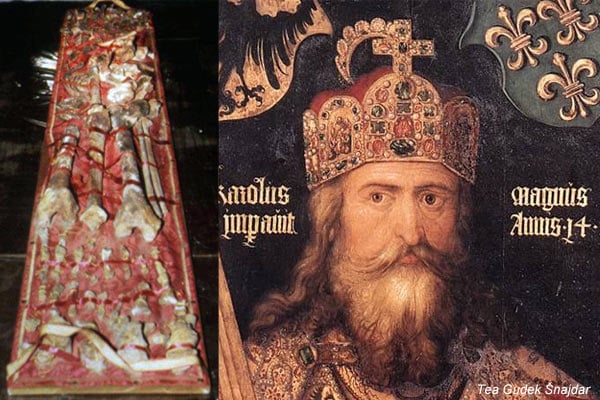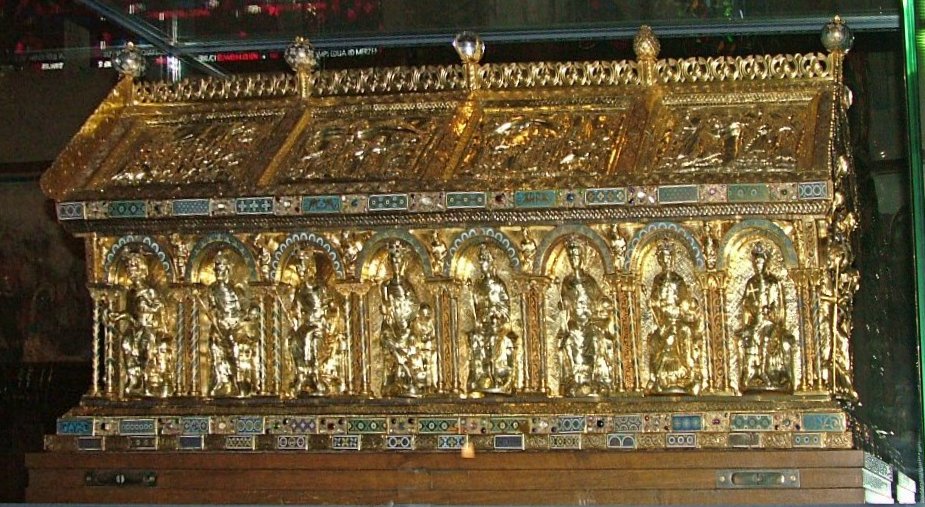German scientists have announced after almost 26 years of research that the bones interred for centuries at Aachen Cathedral are likely to be those of Charlemagne, King of the Franks.
Charlemagne (742-814 AD), who was also known as Charles the Great, was king of the Franks and Christian emperor of the West. He did much to define the shape and character of medieval Europe and presided over the Carolingian Renaissance. After the fall of the Roman Empire, he was the first to reunite Western Europe. He ruled a vast kingdom that encompassed what is now France, Germany, Italy, Austria, and the Low Countries, consolidating Christianity through his vast empire.

The immense territories which Charlemagne controlled became known as the Carolingian empire. Charlemagne introduced administrative reforms throughout the lands he controlled, establishing key representatives in each region and holding a general assembly each year at his court at Aachen. He standardised weights, measures and customs dues, which helped improve commerce and initiated important legal reforms. His cultural renaissance provided the basic tools—schools, curricula, textbooks, libraries, and teaching techniques—upon which later cultural revivals would be based. It is for these reasons, that Charlemagne became known in his time as Carolus Magnus (“Charles the Great”) and Europae Pater (“Father of Europe”).
However, what most historical accounts fail to mention is that Charlemagne, forced conversion to Christianity upon pain of death for failure to convert, and his ‘military accomplishments’ frequently involved extreme brutality, such as the beheading of more than 2,500 Frankish and Saxon village chiefs.

Omens of death
Towards the end of his life, many omens were associated with his impending death. To name just a few, the gallery between the basilica and the palace, which he had built at great pains and labour, fell in sudden ruin to the ground on the day of the Ascension. The wooden bridge over the Rhine at Mayence, which he had constructed with admirable skill, at the cost of ten years’ hard work, was destroyed in hours by a fire. Moreover, one day in his last campaign into Saxony against Godfred, King of the Danes, Charlemagne reported seeing a ball of fire fall suddenly from the heavens with a great light, just as he was leaving camp before sunrise to set out on the march. It rushed across the clear sky from right to left, and everybody was wondering what the meaning of the sign was, when the horse which he was riding was startled and threw Charlemagne heavily to the ground. However, Charlemagne himself despised all these omens and insisted they had no reference to him whatsoever.

The burial of Charlemagne
When Charlemagne died in 814, supposedly of a fever, his remains were buried in the basilica that he had built at his own expense. A gilded arch was erected above his tomb with his image and an inscription. However, over the centuries, his remains were disturbed and moved many times. In the year 1000, Otto III had Charlemagne’s vault opened. In 1165, Emperor Frederick Barbarossa again opened the vault and moved the remains to a sculptured sarcophagus made of marble. In 1215, Frederick II had them again moved, this time to a casket of gold and silver. Charlemagne’s remains were again disturbed in 1349, when a revival of interest in relics, and especially those of Charlemagne, led to the creation of two separate reliquaries to display some of the bones. The Chapel’s choir hall was later reconstructed and the king’s shrine was moved to a new location. Then in the 15th century, more building work was undertaken, expanding the site, resulting in what we now know as Aachen Cathedral.
Numerous attempts were made by archaeologists in the 20th century to find the remains of Charlemagne but they failed to find any evidence that the body of the king was ever placed in Aachen Cathedral. In fact, over the years, there were eight different theories about the burial place of the Carolingian ruler.
Charlemagne’s remains found
In 1988, a team of researchers managed to acquire what they believed were the remains of Charlemagne in Aachen Chathedral. Most of his skeleton was found in an elaborate tomb, a skull was found in a bust of the king, and a shin bone was discovered in Charlemagne’s reliquary – a ceremonial container for remains. Some bones were missing and believed to have been given away as relics at the time of the king’s death.
Now, after 26 years since the rediscovery of the bones, researchers confirmed that the 1,200-year-old remains do in fact appear to be Charlemagne. At 1.84 metres in height, Charlemagne stood above the crowd. He was also described as being particularly slim, and walking with a limp in the last years of his life.
An analysis of the bones matched the height, build and age of Charlemagne, and the kneecap and heel bones had deposits consistent with an injury, which would have resulted in a limp.
One of the scientists studying the remains, Professor Frank Rühli, said: “Thanks to the results from 1988 up until today, we can say with great likelihood that we are dealing with the skeleton of Charlemagne.”